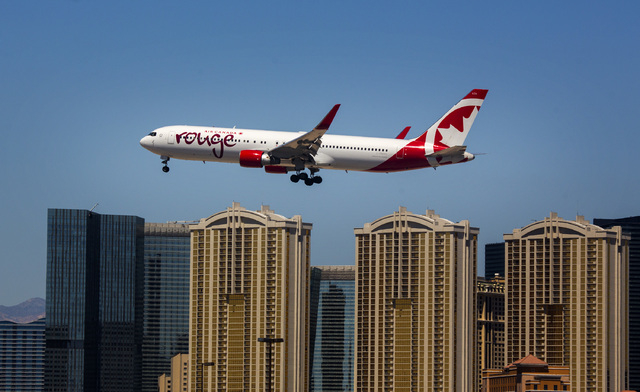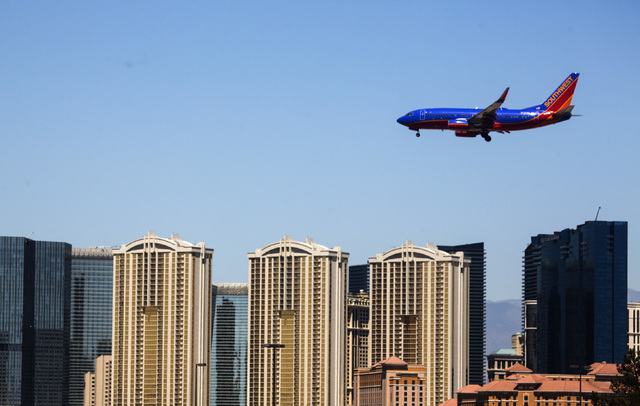Something special in the air: Airline profits
Warren Buffett once said that to become a millionaire all you have to do is make a billion dollars and then buy an airline.
The Berkshire Hathaway CEO invested $358 million in preferred shares of USAir Group in 1989. By 1994, his position had lost 75 percent of its value and Buffett now says that whenever he has the urge to buy airline stock, he calls a toll-free number and says, “My name is Warren and I’m an aeroholic,” and waits for someone to talk him out of it.
Those were the old airline investment days. It’s a new world now with a key difference between two years ago and 2014: Airlines are making money.
They’re generating revenue and cutting costs in all kinds of ways, many of which are playing out among air carriers that operate at McCarran International Airport.
Consider:
■ In April, Southwest Airlines announced that its employees would split $228 million in profit sharing in 2014 based on 2013 profits, up from $121 million a year earlier.
■ Earlier this month, the stocks of three of the four major air carriers operating in the United States hit 52-week high prices. Delta Air Lines hit $42.66 June 5 and American Airlines ($44.43) and Southwest ($27.70) peaked June 9.
■ Even discount carriers’ stock prices are faring well. Las Vegas-based Allegiant Travel Co., parent company of Allegiant Air, hit $124.61 June 6 and Spirit Airlines reached $63.96 June 9.
■ Investment analysts nationwide are singing the praises of airline stocks in their reports. Nearly a year ago, airline analyst Helane Becker of Cowen Securities said the airline industry was engaged in “the four C’s” — consolidation, capacity discipline, charging for everything and capital returns to shareholders.
A STABLE BUSINESS
“It’s a stable business now,” said Mike Boyd, co-founder of Boyd Group International, an aviation consultant based in Evergreen, Colo. “All the lunatics are out of it.”
Boyd, who will bring airline executives from around the world to Las Vegas later this summer for his company’s annual aviation conference, said airline companies have finally found the secret formula for generating profits. As a result, investors are making money along with them.
But some airlines are profiting more at the expense of their customers; passengers are paying more for their tickets and getting fewer perks. But that’s all part of the strategy that has turned the industry from frequent market loser to one with companies that appear on analysts’ “buy” lists.
Airlines have different strategies in their climb to profitability, but the biggest has been consolidation. There’s been a steady progression of mergers in the past four years.
Atlanta-based Delta Air Lines merged with Northwest Airlines in 2010.
Later that year, United Airlines announced it was consolidating with Continental Airlines. In March 2012, the blended companies became known as United Continental Holdings and the merged airline is known as United.
Discounter Southwest Airlines merged with AirTran in April 2011, receiving its operating certificate in May 2012. Through the end of this year, Southwest is continuing to absorb AirTran systems and routes.
Finally, US Airways and American Airlines announced a merger in February 2013, completing the deal in December. The airline, now the world’s largest, has taken on the American name but its key management came from US Airways.
MERGER FALLOUT
Mergers enable airlines to consolidate routes, computer and operations systems and reduce employees with duplicate responsibilities.
Some cities, including Las Vegas, have been hurt by consolidations. When Delta merged with Northwest, Memphis, Tenn., a former Northwest hub, lost flights. Cleveland, a former stronghold for Continental Airlines, lost lift in the United merger.
Southwest ended AirTran service to Key West, Fla., but added flights for Flint, Mich., and Des Moines, Iowa.
For Las Vegas, a merger-related loss of flights occurred in 2005 when US Airways acquired America West Airlines and discontinued a night hub operation at McCarran. The decision to end those flights came as the Great Recession was setting in.
In October 2007, McCarran averaged 586 daily flights. Within nine months, US Airways chopped more than 100 daily flights out of its schedule. The recession further eroded the market and the number of Las Vegas flights further declined gradually with other airline mergers.
In November, there were 441 daily flights. Thanks to growth from international carriers and deep discount airlines such as Spirit Airlines, the number of daily flights is up to 469, still far below the 2007 peak.
CAPACITY RESTRAINT
Some of the decline in flights is because of another of Becker’s four C’s — capacity restraint.
Most airlines are controlling their capacities knowing that with limited supply there’s greater demand. Fewer seats to a market lets airlines charge more for those limited seats. More airplane seats are being filled with revenue passengers.
Allegiant Air’s load factor, the percentage of revenue-paying passengers, has hovered around 90 percent in the past year. In the 1990s, airlines were happy if the percentage was in the high 70s.
Southwest’s flights to Las Vegas are frequently full, especially on Fridays or on dates before major conventions.
Airlines are even cramming more passengers in their planes to increase profitability. Southwest and Allegiant have completed programs to add rows of seats to their planes to increase capacities.
Some airlines are taking a different tack, hoping to woo customers who will pay more for creature comforts with business-class service and amenities.
JetBlue has rolled out a premium product called Mint for transcontinental flying that includes lie-flat bed seats. Virgin America promotes its comfortable cabin features and a robust food menu.
FEE REVENUE
Cashing in on ancillary revenue is another tactic making airlines profitable. Those added amenities and a laundry list of fees are generating even more revenue for the airlines.
The Bureau of Transportation Statistics recently reported that 16 major airlines reported collecting $790 million in bag fees and $726 million in reservation cancellation and change fees. Delta led the pack with $191 million in bag fees and $220 million in change fees.
Locally, Allegiant, an early entry in ancillary-revenue collection, reported $96.1 million in fees and for add-on products in the first quarter, a 9.8 percent increase over the first quarter of 2013.
Airlines also are taking away some of the perks and rewards passengers have enjoyed for years.
“They don’t have to give away products that they can sell otherwise,” Boyd said of the disappearance of some airline perks. “They no longer have to chase business. That’s why frequent-flier programs are changing so abruptly.”
Southwest started a trend in 2011 when it overhauled its Rapid Rewards frequent-flier program, basing awards to participants on the amount of money spent instead of the number of flights flown.
Now, Delta and United are following with similar changes to Delta’s SkyMiles and United’s MileagePlus programs, basing rewards on money spent instead of miles flown.
Robert Mann, an aviation expert with R.W. Mann &Co., said customers have little recourse because just about every airline uses the same tactics.
“As long as you’re safe and the service is tolerable, there’s always going to be a market and with capacity restraint, the airlines are going to continue to grow,” he said.
“United has gone through a rough patch, but it will fix itself. For investors, airlines are going to become even more attractive as these mergers fully take hold.”
FUEL COSTS
But Mann added that investing in airlines still isn’t a free ride to stock market success. There are still factors that can quickly alter an airline’s fortunes. The biggest of those is fuel costs.
Fuel is such a volatile expense that airlines have gone to great measures to make their planes as efficient as possible. They’ve collaborated with manufacturers to develop winglets that let planes fly at peak efficiency.
Some airlines are remaking their fleets, anxious for deliveries of Boeing 787 jets and next-generation 737s and Airbus A350s made of lightweight composite materials that make them the most fuel-efficient planes in the sky.
Allegiant, which flies primarily with fuel-guzzling MD-80 jets is increasing its number of Airbus A320-style jets that not only are more fuel-efficient but have larger capacities than the types of twin-engine jets the airline has flown since its founding.
Most airlines rebuilt their business models to tolerate $100-a-barrel oil prices. When oil prices dipped below those levels, airlines capitalized. But investors get nervous every time there is an international incident that could trigger an oil-price spike. That occurred earlier this month when unrest erupted in Iraq and airline shares dipped.
But, mostly, airlines seemed to have discovered the formula that will let them flourish and even keep Buffett happy.
“It’s like the five families,” Boyd said. “They’re respecting each others’ territory and they’re not killing each other.”
“They operate on very thin margins, but at least they’re profitable.”
Contact reporter Richard N. Velotta at rvelotta@reviewjournal.com or 702-477-3893. Follow him on Twitter @RickVelotta.





















